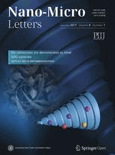
Nano-Micro Letters
Scope & Guideline
Advancing nanotechnology through open collaboration.
Introduction
Aims and Scopes
- Nanomaterials and Nanocomposites:
Research on the synthesis, characterization, and application of various nanomaterials, including carbon-based materials, metal oxides, and hybrid composites, aimed at enhancing performance in energy storage and conversion. - Electrochemical Energy Storage:
Studies related to batteries, supercapacitors, and fuel cells, focusing on novel materials and design strategies that improve efficiency, stability, and energy density. - Environmental Applications:
Investigations into the use of nanomaterials for environmental remediation, including water purification, gas sensing, and pollutant degradation. - Biomedical Applications:
Exploration of nanotechnology in healthcare, including drug delivery systems, biosensors, and therapeutic agents for cancer treatment. - Electromagnetic Interference Shielding:
Research on materials designed for effective electromagnetic interference (EMI) shielding, critical for electronic devices and communication technologies.
Trending and Emerging
- Sustainable Energy Solutions:
A significant trend is the development of sustainable energy technologies, including rechargeable zinc-ion batteries and environmentally friendly energy storage systems that utilize abundant materials. - Advanced Electrocatalysis:
Research is increasingly directed towards novel electrocatalysts for energy conversion processes, such as CO2 reduction and hydrogen evolution, emphasizing efficiency and sustainability. - Smart and Functional Materials:
Emerging focus on multifunctional materials that integrate sensing, actuation, and energy harvesting capabilities for applications in wearable electronics and smart systems. - AI and Machine Learning in Materials Science:
The application of artificial intelligence and machine learning techniques to optimize material design, predict properties, and accelerate research processes is becoming more prominent. - Biomimetic and Bioinspired Materials:
Research on materials that mimic biological systems for applications in healthcare, tissue engineering, and environmental remediation is gaining momentum.
Declining or Waning
- Traditional Solar Cell Technologies:
While innovations in perovskite solar cells continue, the focus on conventional silicon-based solar cells has diminished, as researchers seek more efficient and versatile materials. - Single-Use Nanomaterials:
The interest in single-use or disposable nanomaterials has decreased due to environmental concerns and the push for sustainable and recyclable materials. - Basic Research on Nanotoxicology:
Research dedicated to the fundamental toxicological studies of nanomaterials is becoming less common, likely overshadowed by applied research focused on specific applications and solutions. - Conventional Drug Delivery Systems:
The exploration of traditional drug delivery mechanisms is declining as more attention is drawn towards innovative, targeted, and stimuli-responsive delivery systems.
Similar Journals

JOURNAL OF MATERIALS SCIENCE-MATERIALS IN ELECTRONICS
Illuminating the Future of Electronics through Materials InnovationJOURNAL OF MATERIALS SCIENCE-MATERIALS IN ELECTRONICS, published by Springer, is a distinguished international journal that serves as a vital platform for the dissemination of cutting-edge research in the field of materials science, with a keen focus on electronics. Since its inception in 1990, this journal has consistently contributed to the advancement of knowledge across a range of interdisciplinary categories, including Atomic and Molecular Physics, Optical and Magnetic Materials, and Biomedical Engineering, achieving notable quartile positions in various 2023 Scopus rankings. With an impact factor that signifies its scholarly influence, this journal provides a rigorous peer-reviewed environment for researchers and practitioners to share innovative ideas, experimental findings, and theoretical developments. Although it does not currently offer open access options, the depth and breadth of topics covered—including condensed matter physics and bioengineering—make it an essential resource for those at the forefront of materials research. With a commitment to bridging the gap between theory and practical application, the JOURNAL OF MATERIALS SCIENCE-MATERIALS IN ELECTRONICS continues to pave the way for future explorations in the ever-evolving landscape of materials science.

BULLETIN OF MATERIALS SCIENCE
Charting New Territories in Materials InnovationBulletin of Materials Science, published by the Indian Academy of Sciences, is a distinguished journal that has been contributing to the field of materials science since its inception in 1979. With an ISSN of 0250-4707 and E-ISSN 0973-7669, it provides a platform for researchers to share groundbreaking studies and advancements in the mechanics of materials and general materials science. As of 2023, the journal holds a respectable Q3 ranking in both the Materials Science (miscellaneous) and Mechanics of Materials categories, highlighting its competitive position in the academic landscape. Although the journal currently does not operate under an open access model, it remains a vital resource for professionals and students keen on exploring innovative material developments and methodologies. With a commitment to promoting high-quality research, the Bulletin of Materials Science features rigorous peer-review processes, making it an essential reference for anyone engaged in the materials science domain.

Advanced Materials Interfaces
Connecting Ideas, Innovating InterfacesAdvanced Materials Interfaces is a premier journal dedicated to the exploration and advancement of materials science, with particular emphasis on the interfacial phenomena that govern the behavior of materials in various engineering applications. Published by WILEY in the United Kingdom, this Open Access journal, established in 2014, has quickly ascended to a Q1 category ranking in both Mechanical Engineering and Mechanics of Materials as of 2023, reflecting its significant influence and excellence in the field. With impressive Scopus Ranks, such as #81 out of 672 in Mechanical Engineering and #58 out of 398 in Mechanics of Materials, it serves as a vital resource for researchers and practitioners aiming to push the boundaries of materials innovation. The journal provides unrestricted access to its cutting-edge research, promoting collaboration and dissemination of knowledge among the global scientific community, solidifying its role as a vital contributor to the ever-evolving landscape of materials engineering.
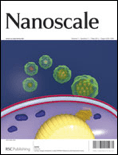
Nanoscale
Transforming Innovations at the Nanoscale.Nanoscale is a premier academic journal published by the Royal Society of Chemistry, dedicated to advancing the field of nanoscience and nanotechnology. With both its ISSN (2040-3364) and E-ISSN (2040-3372) ensuring wide accessibility, the journal is renowned for its high-impact research contributions, reflected in its impressive 2023 Impact Factor and prestigious Q1 ranking in both Materials Science (Miscellaneous) and Nanoscience and Nanotechnology categories. Since its inception in 2009, Nanoscale has fostered a collaborative platform where leading researchers from around the globe share their innovative findings across a multitude of topics spanning from material synthesis to applications in nanotechnology. The journal not only serves as a valuable resource for professionals, researchers, and students but also actively engages the academic community in discussing emerging trends, thus shaping the future of nanoscience. Situated in the heart of the UK at Thomas Graham House, Science Park, Milton Rd, Cambridge CB4 0WF, Nanoscale remains a key publication for those looking to keep abreast of the latest breakthroughs in an ever-evolving field.
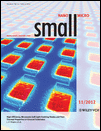
Small
Unveiling the Power of Small in Science and Technology.Small is a premier academic journal published by WILEY-V C H Verlag GmbH, focusing on cutting-edge research across a multitude of disciplines including biomaterials, biotechnology, chemistry, engineering, materials science, medicine, and nanoscience. With an impressive impact factor and recognized in the top quartile (Q1) across these categories, Small serves as a vital platform for scientists and researchers aiming to disseminate innovative findings and explore the interplay between small-scale materials and their large-scale applications. Enjoying a broad readership, the journal has been key in advancing knowledge from its inception in 2005 and aims to foster collaborations and discussions that steer the future of material science and biotechnology. Though not open access, research published in Small remains invaluable for professionals and students eager to explore the advancements at the nanoscale, promoting a comprehensive understanding of modern scientific challenges and opportunities.
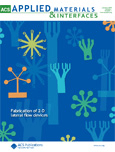
ACS Applied Materials & Interfaces
Exploring Breakthroughs in Materials Science and InterfacesACS Applied Materials & Interfaces, published by the American Chemical Society, stands as a leading journal in the field of applied materials, nanotechnology, and interdisciplinary research in medicine. With an impressive Impact Factor that places it in the Q1 category across Materials Science, Medicine, and Nanoscience and Nanotechnology, this journal consistently ranks among the top tier, evidencing its significance and influence in advancing scientific knowledge. The journal’s scopus ranking of 33 out of 463 in General Materials Science further underscores its critical role in disseminating innovative and high-quality research. Although it is not an open-access journal, a diverse range of access options is available, ensuring that vital research findings are accessible to a broad audience of researchers, professionals, and students. Targeting breakthroughs in the synthesis, characterization, and application of materials and interfaces, ACS Applied Materials & Interfaces serves as a pivotal platform for publishing cutting-edge studies essential for future technological advancements.
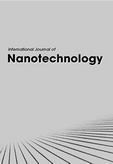
International Journal of Nanotechnology
Advancing the Frontiers of Nanotechnology ResearchInternational Journal of Nanotechnology, published by INDERSCIENCE ENTERPRISES LTD, is a prominent academic platform dedicated to advancing research in the rapidly evolving field of nanotechnology. With an ISSN of 1475-7435 and an E-ISSN of 1741-8151, this journal has been contributing valuable insights and innovative findings since its inception in 2004. Although currently not an open-access publication, it serves as an essential resource for researchers, professionals, and students alike, encompassing critical areas such as bioengineering, condensed matter physics, and materials science. The journal is indexed in Scopus, highlighting its academic rigor, albeit ranking in the lower quartiles across several categories. As it progresses towards its 2024 milestone, the International Journal of Nanotechnology continues to play a crucial role in fostering collaborative scientific discourse and pushing the boundaries of knowledge in nanoscience. With a distinguished reputation in the United Kingdom and beyond, it is a vital tool for anyone looking to stay at the forefront of nanotechnology advancements.

ACS Applied Nano Materials
Pioneering the Future of Applied Nanotechnology.ACS Applied Nano Materials, published by the American Chemical Society, is a premier journal that serves as a vital resource in the rapidly evolving field of nanomaterials. With a commendable impact factor placing it in the Q1 category of Materials Science in 2023, this journal has established itself as a leading platform for disseminating high-quality research that showcases innovative applications and advancements in nanomaterial science. Since its inception in 2018, it has consistently aimed to bridge the gap between fundamental research and practical application, making it a crucial reference for researchers, professionals, and students interested in cutting-edge nanotechnology. Access options for the journal encourage collaboration and knowledge sharing within the scientific community, reflecting the journal's commitment to fostering advancements in the field. With its base in Washington, D.C., ACS Applied Nano Materials is positioned at the forefront of scientific dialogue, exploring the implications of nanomaterials in various domains, ultimately contributing to technological innovations that impact everyday life.
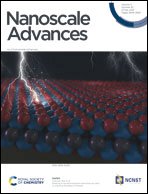
Nanoscale Advances
Innovating at the Nanoscale for Tomorrow's Solutions.Nanoscale Advances, published by the Royal Society of Chemistry, stands out as a leading open-access journal dedicated to advancing the field of nanoscience and nanotechnology since its inception in 2018. With a specialized focus on areas such as atomic and molecular physics, bioengineering, chemistry, and materials science, this journal has consistently achieved top-tier rankings across several categories, reflecting its high-impact contribution to research and innovation. Currently classified in the Q1 quartile for both Atomic and Molecular Physics and Chemistry (Miscellaneous), and Q2 for Bioengineering, its prestige is underscored by impressive Scopus rankings, including a notable 34th position in General Engineering. With its commitment to disseminating high-quality research, Nanoscale Advances serves as an invaluable resource for researchers, professionals, and students alike, fostering collaboration and scholarly exchange in the rapidly evolving landscape of nanotechnology.

Nano Materials Science
Advancing the Frontiers of Nanotechnology.Nano Materials Science is a premier open-access journal dedicated to the dissemination of groundbreaking research in the fields of nanotechnology, materials science, and chemical engineering. Published by KEAI PUBLISHING LTD, this journal has quickly established itself as a leading platform in its area since its inception in 2019, with impressive rankings in the Scopus database, holding a Q1 position across multiple categories, including Chemical Engineering and Materials Science. Based in Beijing, China, Nano Materials Science provides researchers and practitioners access to a wealth of high-quality peer-reviewed articles, fostering innovation and collaboration within the scientific community. With its impact factor steadily rising and a commitment to open access, the journal aims to bridge the gap between theoretical research and practical applications, making it an essential resource for professionals and students eager to stay at the forefront of materials research and nanotechnology advancements.